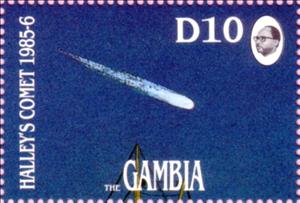Stamp: Comet (Gambia 1986)
Comet (Gambia 1986)
01 March (Gambia ) within release Halley’s Comet goes into circulation Stamp Comet face value 10 Gambian dalasi
| Stamp Comet in catalogues | |
|---|---|
| Michel: | Mi: GM 616 |
Stamp is square format.
Stamp from Souvenir SheetAlso in the issue Halley’s Comet:
- Stamp - Maria Mitchell face value 10;
- Stamp - Apollo 11, Neil Armstrong face value 20;
- Stamp - Skylab 4, Kohoutek Comet face value 75;
- Stamp - NASA Infrared Astronomical Satellite face value 1;
- Stamp - Comet sighting face value 2;
- Stamp - NASA's International Cometary Explorer Satellite face value 10;
- Souvenir Sheet - Comet face value 10;
- Stamp - Comet face value 10;
|
Data entry completed
56%
|
|
|---|---|
| Stamp Comet in digits | |
| Country: | Gambia |
| Date: | 1986-03-01 |
| Print: | Offset lithography |
| Perforation: | 14¼ |
| Emission: | Commemorative |
| Format: | Stamp |
| Face Value: | 10 Gambian dalasi |
Stamp Comet it reflects the thematic directions:
A comet is an icy, small Solar System body that warms and begins to release gases when passing close to the Sun, a process called outgassing. This produces an extended, gravitationally unbound atmosphere or coma surrounding the nucleus, and sometimes a tail of gas and dust gas blown out from the coma. These phenomena are due to the effects of solar radiation and the outstreaming solar wind plasma acting upon the nucleus of the comet. Comet nuclei range from a few hundred meters to tens of kilometers across and are composed of loose collections of ice, dust, and small rocky particles. The coma may be up to 15 times Earth's diameter, while the tail may stretch beyond one astronomical unit. If sufficiently close and bright, a comet may be seen from Earth without the aid of a telescope and can subtend an arc of up to 30° (60 Moons) across the sky. Comets have been observed and recorded since ancient times by many cultures and religions.
Outer space (or simply space) is the expanse that exists beyond Earth's atmosphere and between celestial bodies. It contains ultra-low levels of particle densities, constituting a near-perfect vacuum of predominantly hydrogen and helium plasma, permeated by electromagnetic radiation, cosmic rays, neutrinos, magnetic fields and dust. The baseline temperature of outer space, as set by the background radiation from the Big Bang, is 2.7 kelvins (−270 °C; −455 °F)


